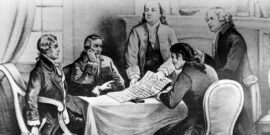The Founders displayed the power of man's rational nature, instead of merely asserting it.
The Jeffersonian Ideal
Thomas Jefferson was a complicated man. He owned over 600 enslaved people throughout his life, but he also famously wrote that “all men are created equal.” He was a passionate revolutionary, but he also became an icon to certain conservatives. Like the country he helped found, Jefferson contained multitudes.
Liberty Fund senior fellow Hans Eicholz, in his book Harmonizing Sentiments, has set out to uncover the “coherent political tradition” amidst these complications and contradictions. Originally published in 2001, a second edition was released earlier this year addressing new developments in the scholarship of the Founding. Citing a famous 1825 letter he wrote to Henry Lee, Eicholz looks to Jefferson to help understand the “American mind.”
More than just another biography of the man, Harmonizing Sentiments is a full history of Jeffersonian thought. Eicholz contextualizes the Virginian’s contradictions within the wider political and cultural conditions of early American life. The ideas animating the American Revolution did not emerge in a vacuum, and the Declaration of Independence was not revealed from on high by some mysterious source. Nor were they the province of a single man, even Jefferson. Rather, they were the result of complex historical processes Eicholz skillfully reconstructs.
For Eicholz, the central idea of early American politics is the concept of “self-government.” At the end of the day, all the members of the independence movement prized personal liberty and decentralization, whether their initial premises came from Enlightenment theory, Christian theology, the Whig political experience, or just plain common sense. As a consensus document, then, Eicholz contends that the Declaration itself “represents an application of the highest public reasoning respecting personal and political independence—what Jefferson would call ‘the harmonizing sentiments of the day,’ and what modern scholars would readily recognize as the ideal typical notions of self-government in their fullest articulation at the time.” Self-government was a virtue that held the fractious founding generation together. It gave them a concrete ideal around which to unite, a cause for which to fight.
Eicholz sets this thesis up in contrast to two other major tendencies in contemporary historical accounts of the Revolution. The first is represented by the wide variety of historiographical schools debating which of the “bewildering array of competing voices” within the Founding to emphasize—liberal versus republican, Christian versus Enlightenment, agrarian versus commercial. As historiographical debates wore on through the twentieth century, Eicholz points out, many historians simply came to believe that there was no coherent core to American political thought.
More troubling is the second tendency Eicholz challenges. Rather than address the cacophony of ideas, many scholars today instead “seek to find a hidden economic spring or mechanism underlying the movement to independence in the exploitation of land and labor.” These Marxists, critical theorists, and other assorted leftists reject the notion that any ideals operated in the founding of this country. They reduce all of history to a clash of power structures, a story of oppression.
Eicholz demonstrates how scholars exhibiting both these tendencies ironically neglect the Founders’ consensus about the nature of power. Throughout the Imperial Crisis of the 1760s and 1770s, American colonists genuinely saw the designs of “absolute despotism” in the way the British Parliament exercised power over them. Those fears inspired a great reevaluation of the relationship between liberty and power, culminating in the emergence of a distinctively American school of political thought, which Eicholz labels the “Old Whigs.”
When Lincoln wrote “All honor to Jefferson” for writing the Declaration as a “a rebuke and a stumbling-block to the very harbingers of re-appearing tyranny and oppression,” he was appealing to the same “harmonizing sentiments” Eicholz outlines.
Old Whigs, as opposed to the “New Whigs” advocating parliamentary supremacy, believed that no human being had the right to absolute power. They rejected Hobbesian notions of sovereignty and the centralization common in Europe. Instead, they saw society as a complex network of mutually restraining authorities carefully balanced to promote happiness and virtue among citizens. Absolute power in the hands of one man or group of men would heedlessly rip through these arrangements.
By the 1770s, despotic imperial policies were becoming an affront to both the colonies’ historical relationship with Parliament and the Old Whigs’ deeply held sense of natural right. As Eicholz puts it:
Uncontrolled power was what they feared. Their understanding of both history and natural rights directed attention to what they affirmed. These were sources of authority and order that originated in society from the people, not from those in possession of raw power. It was a boldly self-assured faith … that the colonists could lead orderly lives independently of Parliament’s imperial hierarchy.
Wisely, Eicholz avoids hailing Jefferson as the sole prophet of this Old Whig perspective. He may have been the principal author of the first draft of the Declaration, but the final draft was truly a product of the Continental Congress’s deliberations. In fact, Jefferson was unhappy with some of the revisions to the document—he felt that they undercut his more radical intentions.
Jefferson was also somewhat dissatisfied with the United States Constitution when it was adopted in the 1780s. Although some scholars consider the Declaration a sort of “key” for understanding the Constitution, Eicholz demonstrates the historical record is more complicated. Anti-Federalists and Jeffersonians, including the Virginian himself, felt that the Constitution did too little to restrain federal power and protect the rights of the people. Other Founders, including Jefferson’s friend and ally James Madison, disagreed, and saw the Constitution as a proper expression of American self-government. For Eicholz, the “harmonizing sentiments” are not a rigid ideological system, but rather a shared set of premises that can be used to reason to different legitimate conclusions.
Perhaps the most difficult challenge to the “harmonizing sentiments,” though, was the painful hypocrisy of chattel slavery, which Eicholz confronts throughout the book. The “peculiar institution” was a concentration of the kind of absolute power the Old Whigs said they hated, but many—including Jefferson himself—were too afraid of the disruptive social consequences to take real action against it. Eicholz quotes free-born African American Benjamin Banneker’s rousing letter to Jefferson to express the utter moral failure that was the continued enslavement of millions.
At the same time, though, Old Whig ideas undeniably contributed to the ultimate liberation of enslaved people. When Abraham Lincoln, the Great Emancipator, wrote in 1859 “All honor to Jefferson” for writing the Declaration as a “a rebuke and a stumbling-block to the very harbingers of re-appearing tyranny and oppression,” he was appealing to the same “harmonizing sentiments” Eicholz outlines in this book. Jefferson, the Declaration, and the War for Independence became a symbol inspiring many to fight for their rightful freedom.
In many respects, this narrative in Harmonizing Sentiments is similar to the account of the American Founding that Russell Kirk provides in The Conservative Mind. Like Eicholz, Kirk saw American liberty as a broad inheritance from many sources united in a rejection of absolute power. Casting his view further along the timeline, though, Kirk also argued that Jefferson’s faction was too eager to solve the problems of independence “by the application of a priori concepts”—not altogether unlike absolutist French Jacobins.
Many conservatives saw Jeffersonianism, calcified into an ideology, as a threat to American self-government. As secretary of state, vice president, and eventually president, Jefferson overemphasized certain aspects of the “harmonizing sentiments” at the expense of others—and his more fanatical followers took their revolutionary spirit even further than he did. Kirk therefore preferred John Adams and George Washington as the Founding’s truly representative statesmen; their conservatism better embodied the American consensus about liberty than Jefferson’s radicalism.
Elsewhere, however, Kirk was somewhat less critical of Jefferson. In a 1941 essay, “Jefferson and the Faithless,” he pitted the Virginian’s populist streak against the bureaucratic centralism of the New Dealers. “Jeffersonian democracy is stronger than these men, stronger than any man,” he wrote.
It may be that the common people in whom [progressives] have no faith will yet show the might Jefferson saw in them; it may be that they no longer have that power. Jeffersonianism may die, but, stand or fall, it has made manifest its essential rightness and its essential virtue.
As a symbol at least, Kirk believed the Sage of Monticello could still inspire Americans to recover their heritage of self-government.
The Founders may have spoken in elevated tones about freedom and virtue, but the sad fact is people don’t talk that way anymore. In the updated bibliographic essay, though, Eicholz concludes that the aim of Harmonizing Sentiments “was to recapture a sense of the meaning of the Declaration of Independence.” Perhaps through books like this, we can inspire people to think that way again.


